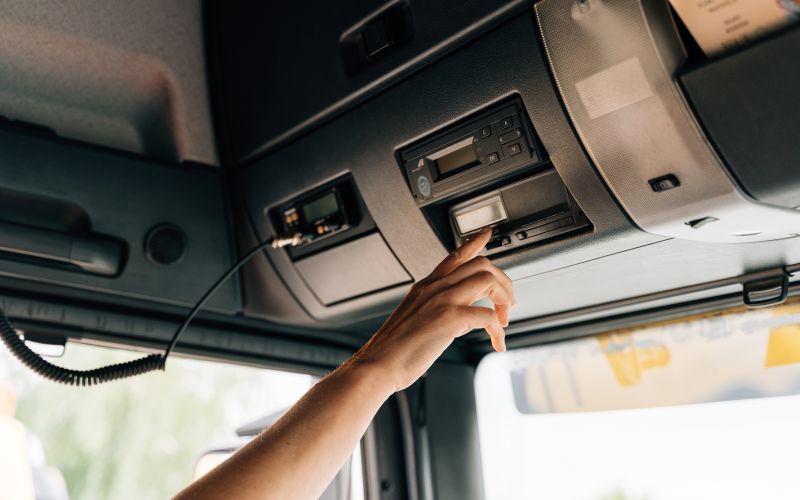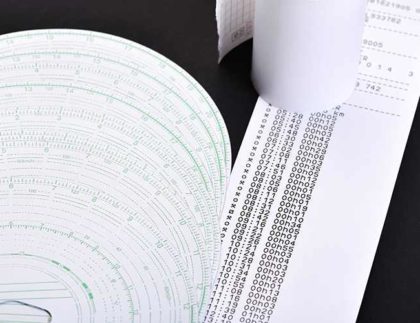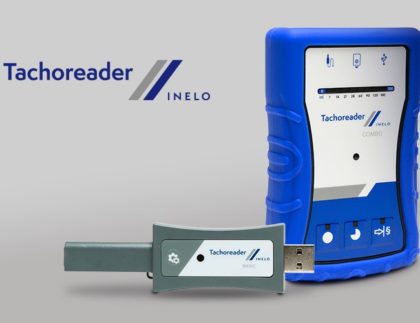
Tachograph manual entry is a seemingly simple issue, which causes various concerns to drivers and carriers. In this article, we will try to clarify any ambiguities and provide a complete guide on this subject. We will describe how to make a manual entry, address the current legal provisions and discuss the situations when a tachograph entry is necessary. Read ahead!
What is a manual tachograph entry?
So, what is a manual tachograph entry? Simply put, it is a procedure which plays a key role in the correct completion of driver’s activity in situations when their card is not present in the recording device. It is necessary to correctly record the course of work then. Remember that a driver has to demonstrate continuity of the activities which took place within the inspected period – 28 days backwards and the current day in the case of an on-road inspection. In turn, this period is one year for inspections carried at the company. When creating a manual entry, the driver has the obligation to note any relevant information related to their actions on the road in detail.
The rules for creating manual tachograph entries vary depending on the type of the device installed in the vehicle. For digital tachographs, a driver needs to make an entry after inserting their driver card, while for analogue tachographs, the entry should be placed on the rear of the chart.
Why are manual entries important?
The basic reason to use manual tachograph entries is the necessity to avoid sanctions imposed by inspection agencies. When no activity is recorded on the driver card or record sheet, an inspector cannot determine whether the driver used their free time or was active and, for example, performed warehouse works in a specific period.
Therefore, a manual entry is a form of driver’s declaration on what activities they performed when their card (or analogue chart) was outside of the device. You should know the rules for making manual tachograph entries, as their correct completion allows to avoid penal sanctions and conflicts with inspection bodies.
When should a manual entry be made?
Drivers must make a manual entry on a digital tachograph each time after inserting their card into the recording device – this applies to the period of no data preceding the logging of the card on the tachograph. It is important to be very careful – if a driver makes a mistake when creating an entry, it won’t be possible to enter the data again after retransferring and reinserting the card. Please note that, after a manual entry is made, it is impossible to go back to the periods when data recording gaps occurred. Remember also that a manual entry only allows to complete the data period from the time a driver card was last inserted to the moment it is reinserted to the tachograph.
For analogue tachographs, a recommended practice is to complete the activities on the rear of the chart on an ongoing basis. This allows to maintain information on all driver’s activities required during inspection.
How to correctly make a manual entry step by step?
The law does not impose any strictly determined manner of entering the data and the manual entry methods may vary depending on the device manufacturer and specific model. The most popular tachographs on the market include the devices from Siemens (VDO) and Stoneridge. As the regulations evolve and legal changes occur, the manufacturers adjust the user interfaces to the new requirements.
It should be noted that older tachograph models manufactured before October 2011 may be significantly less intuitive than the more recent devices. Making a correct manual entry with them can be troublesome, especially for less experienced drivers. This matter looks a lot simpler for newer models – completing the necessary information, for example, entering rest for the missing period, is in practice limited to pressing the “OK” button a few times on them.
It is important that the driver is familiar with the tachograph model installed in their vehicle. Additionally, working with newer driver card and tachograph readers, such as Tachoreader Combo for example, not only allows to meet the statutory requirements in relation to downloading and archiving all necessary data, but also increases the working experience and may contribute to the reduction of empty runs.
The most common manual entry errors
Pursuant to the applicable laws, each new vehicle should be equipped with the newest recording device. This results in gradually decreasing the number of trucks in which the drivers still use older tachographs.
An important issue is the deadline for replacing tachographs in cars used to perform international transport orders. The laws stipulate that the carriers who carry out international transport must replace their tachographs with devices manufactured after 15 June 2019 by the end of 2024.
The tachographs manufactured before October 2011 require certain precision and knowledge on how to make a manual entry. However, for newer models, recording the entire rest period is limited to one simple step – pressing the appropriate button.
Errors still happen during manual data recording, but they are increasingly less frequent. Routine is the main source of irregularities – inserting the card into the tachograph and getting engaged in the performance of other responsibilities. The possibility to enter the driver’s activity is disabled after one minute without any interaction with the device, leaving the period without any data entered. Although less common, improper selection of the driver’s activity is another error. For example, another activity, such as disposition or other work, can be recorded instead of the rest period. In turn, this leads to missing proper documentation of necessary daily or weekly rest.
Manual entries and legal provisions
The obligation to create manual tachograph entries arises directly from the European Union legislation, namely Article 34 section 3 of Regulation (EU) No. 165/2014 of the European Parliament and of the Council:
- When, as a result of being away from the vehicle, a driver is unable to use the tachograph fitted to the vehicle, the periods of time referred to in points (ii), (iii) and (iv) of paragraph 5(b) shall:
- a) if the vehicle is fitted with an analogue tachograph, be entered on the record sheet, either manually, by automatic recording or other means, legibly and without dirtying the record sheet; or
- b) if the vehicle is fitted with a digital tachograph, be entered onto the driver card using the manual entry facility provided for in the tachograph.
In this context, Article 6 section 5 of Regulation (EC) No. 561/2006 of the European Parliament and of the Council, which discusses the rules for qualifying and recording the activities specified as “other work”, is also important.
Practical tips for manual entries
The procedure of making manual tachograph entries is not complicated regardless of the device manufacturer or type. In the training practice, it is often observed that a driver knows how to make a manual entry and is able to do it independently after getting initially familiar with the appropriate steps.










